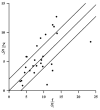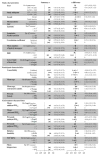Estimating error in using ambient PM2.5 concentrations as proxies for personal exposures: a review
- PMID: 20087191
- PMCID: PMC5370079
- DOI: 10.1097/EDE.0b013e3181cb41f7
Estimating error in using ambient PM2.5 concentrations as proxies for personal exposures: a review
Abstract
Background: Several methods have been used to account for measurement error inherent in using ambient concentration of particulate matter < 2.5 microm/m(3) (PM(2.5)) as a proxy for personal exposure. Such methods commonly rely on the estimated correlation between ambient and personal PM(2.5) concentrations (r). However, studies of r have not been systematically and quantitatively assessed for publication bias or heterogeneity.
Methods: We searched 7 electronic reference databases for studies of the within-participant correlation between ambient and personal PM(2.5).
Results: We identified 567 candidate studies, 18 (3%) of which met inclusion criteria and were abstracted. The studies were published between 1999 and 2008, representing 619 nonsmoking participants aged 6-93 years in 17 European and North American cities. Correlation coefficients (median 0.54; range 0.09-0.83) were based on a median of 8 ambient-personal PM(2.5) pairs per participant (range 5-20) collected over 27-547 days. Overall, there was little evidence for publication bias (funnel plot symmetry tests: Begg's log-rank test, P 0.9; Egger's regression asymmetry test, P 0.2). However, strong evidence for heterogeneity was noted (Cochran's Q test for heterogeneity, P = 0.001). European locales, eastern longitudes in North America, higher ambient PM(2.5) concentrations, higher relative humidity, and lower between-participant variation in r were associated with increased r.
Conclusions: Characteristics of participants, studies, and the environments in which they are conducted may affect the accuracy of ambient PM2.5 as a proxy for personal exposure.
Figures




References
-
- Brauer M, Brumm J, Vedal S, Petkau AJ. Exposure misclassification and threshold concentrations in time series analyses of air pollution health effects. Risk Anal. 2002;22(6):1183–93. - PubMed
-
- Yeh S, Small MJ. Incorporating exposure models in probabilistic assessment of the risks of premature mortality from particulate matter. J Expo Anal Environ Epidemiol. 2002;12(6):389–403. - PubMed
-
- Dominici F, Zeger SL, Samet JM. A measurement error model for time-series studies of air pollution and mortality. Biostatistics. 2000;1(2):157–75. - PubMed
-
- Hunter JE, Schmidt FL. Correcting Error and Bias in Research Findings. 2. Sage Publications, Inc; 2004. Methods of Meta-Analysis.
Publication types
MeSH terms
Substances
Grants and funding
LinkOut - more resources
Full Text Sources
Miscellaneous

